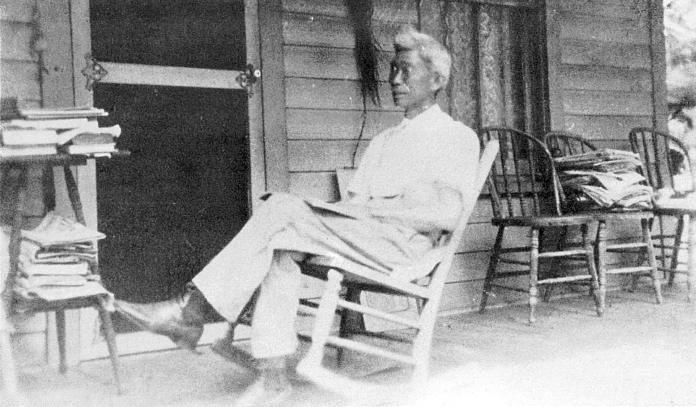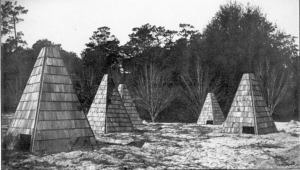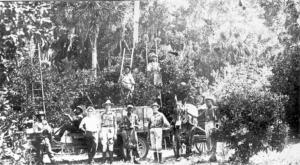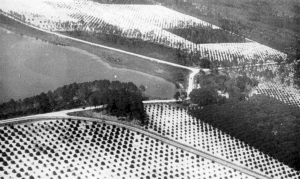
The early years of the 1890s were indeed proud ones for the city of DeLand, and the minutes of the Old Settlers’ annual meetings reveal an abiding attitude of optimism.
In 1891, the group met in the home of Mrs. Killcoff on “a typical New Year’s Day of balmy atmosphere and sunshine,” as noted by Secretary Hettie Austin.
The women carried in several “well-filled baskets,” and all those gathered around the tables did “ample justice to an elegant dinner.”
New Year’s Day of 1892 again brought bountiful sunshine to the Old Settlers’ gathering, and picnic baskets overflowed once more when 50 members met at the home of John Banta. Much of the meeting time was taken up in recalling the difficulties of the early years that were in such contrast with the prosperity they now enjoyed.

of our feature Better Country Beyond, with excerpts from DeLandite
Karen Ryder’s, pictured, book about the early days of the founding of the city of DeLand.
The Beacon is indebted to Donna Jean Flood, a DeLand financial adviser
with Edward Jones, for the idea for this series, part of our ongoing West Volusia Memories series by community writers.
The high spirits of the group continued for their 1893 gathering, as well.
At this gathering, two new families were admitted under the recent eligibility changes made to the bylaws. In other business, plowman Thomas Brinly was honored for “the active part he took in assisting to develop this country in her early days.”
In April of that year, a woman identified only as “Miss Robinson” and all the pupils in her private school took part in an innovative, two-day “business carnival” at the Putnam Inn. Each business in town was represented by children wearing costumes depicting the work of the business.
The residents were happily entertained by this novel presentation, and most believed that the continued upward curve in the city’s prosperity would be sustained well into the future.
That same month, when the Town Council met, the mood of heightened optimism was reinforced by financial data that was presented. The city’s first-ever yearly budget was considered quite sound at $5,604.

PROTECTION — After devastating losses in the freezes of 1894 and 1895, citrus growers developed innovative ways to protect their crops, like these wood-shingle pyramids photographed in about 1900.
In other business conducted that day, two more health ordinances were passed: Fowl were prohibited from running loose within the city limits, and, in all places where food was sold or served, flytraps were required at the front and back doors. This former settlement of farmers and homesteaders was gradually gaining a more urbane lifestyle.
However, the seemingly unrelenting prosperity of the city would take a sudden and drastic downturn before the Old Settlers gathered for their next meeting.

IT TAKES A CREW — This 1923 photograph shows members of the citrus-management crew in a James W. Perkins grove on Highway 11 north of DeLand.
The big freeze
The citrus industry, the engine that drove all the area’s initial development in the early 1870s, remained the major force in DeLand’s prosperity through the early years of the 1890s.
By 1894, the orange crop alone had swelled to 146,000 boxes, and a newspaper editorial could proudly boast that oranges were 26 times as profitable as cotton.
It was said that “many homes were virtually buried in a sea of orange trees.”
With this perspective in mind, it is easier to comprehend how the severe back-to-back freezes that struck the area in the winter of 1894-95 could wreak the kind of economic havoc that they did.
The catastrophe was particularly ill-timed, coming just as the city was poised for a jubilant celebration of the 20th anniversary of its founding.

EAT AN ORANGE — citrus came back after the devastating 1894 and 1895 freezes. These groves are near Lake Winnemissett on DeLand’s east side.
Orange trees, under the right conditions, are hardy and long-lived. Unfortunately, over time, as more of the overstory pine forests were cut, killing freezes took hold more easily.
By 1894, most of the area’s citrus growers had experience in coping with freeze damage. Many still remembered the freeze of 1886 as particularly devastating. In fact, it was Henry DeLand’s losses from that disaster that led the trustees of DeLand University to seek another wealthy patron for the school in the person of the then newly arrived Philadelphia hatmaker, John B. Stetson.
Yet despite the vivid and lingering memories of that event’s destruction, no one could have been prepared for the level of annihilation that would occur in the winter of 1894-95 and how abruptly it would bring the mighty steamroller pace of the two-decade-long citrus craze to a crashing halt.
— Ryder and her husband, Bob Wetton, live in DeLand and are active members of the West Volusia Historical Society. To order a copy of her book Better Country Beyond, call the Historical Society at 386-740-6813, or email delandhouse@msn.com.
[…] Better Country Beyond: Progress … and then the big freeze – The West Volusia Beacon […]